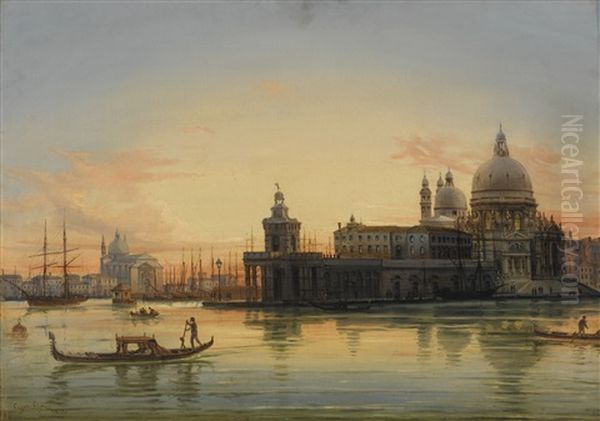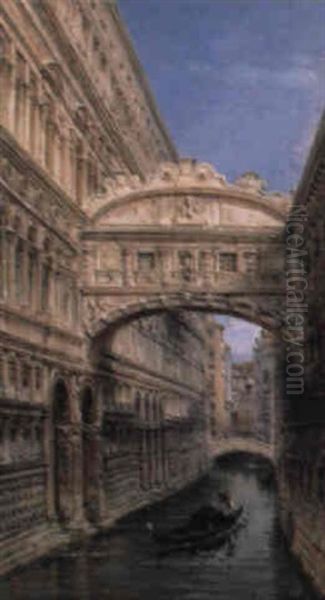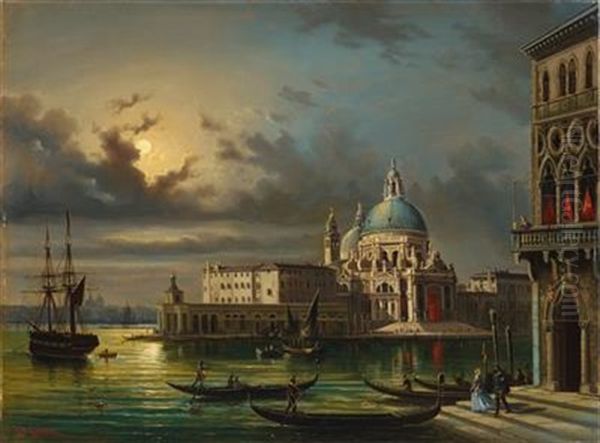Introduction: A Venetian Painter of German Origin
Giovanni Grubacs (1829-1919) stands as a significant figure in the rich tapestry of 19th-century Venetian art. Though born in Germany, Grubacs spent the vast majority of his long life in Italy, specifically in the city that would become the sole focus of his artistic output: Venice. He emerged as a prominent landscape painter, specializing in the detailed and evocative cityscapes known as vedute, carrying forward a tradition deeply embedded in Venetian artistic identity. His work, celebrated for its meticulous detail and atmospheric sensitivity, continues to be admired in collections around the world.
He was not the first in his family to pursue this path. Giovanni was the son of Carlo Grubacs, himself a respected painter known for his depictions of Venice. This familial connection undoubtedly played a crucial role in shaping Giovanni's artistic direction, immersing him from an early age in the techniques and subjects that defined the Venetian school of painting. Inheriting this legacy, Giovanni Grubacs dedicated his career to capturing the unique beauty and enduring allure of Venice, its canals, palaces, and bustling public spaces.
Despite his German roots, Giovanni Grubacs became intrinsically linked with Venice, eventually settling there permanently. He rose to become one of the key representatives of the 19th-century Venetian landscape painting movement. His long life, spanning ninety years, allowed him to witness significant changes in the city, yet his art remained largely focused on the timeless vistas that had captivated artists for centuries. He passed away in his adopted city in 1919, leaving behind a substantial body of work that testifies to his skill and his deep affection for Venice.
Early Life and Artistic Formation
Giovanni Grubacs' journey into the world of art began under the direct influence of his father, Carlo Grubacs. Growing up in an artistic household provided an environment where the skills of observation and depiction were likely nurtured from a young age. The family itself had origins tracing back to Perasto, in Eastern Europe, before establishing themselves in the vibrant artistic milieu of Venice. This background provided Giovanni with a direct link to the established practices of Venetian view painting.

Formal training complemented this familial immersion. Sources indicate that Giovanni Grubacs entered the prestigious Accademia di Belle Arti (Academy of Fine Arts) in Venice in 1818. This institution was a cornerstone of artistic education in the city, particularly after its revitalization under the guidance of the influential scholar and arts administrator Leopoldo Cicognara. The Academy aimed to provide systematic training to Venice's most promising artists, fostering their development and supporting their careers through initiatives like annual exhibitions. (Note: The 1818 entry date stated in source materials appears remarkably early given Grubacs' birth year of 1829; however, it is reported here as found in the reference information).
His education at the Accademia would have exposed him to rigorous training in drawing, perspective, and painting techniques. It was within this structured environment, combined with the ongoing influence of his father's work and the pervasive artistic heritage of Venice itself, that Giovanni developed his distinct approach. He absorbed the lessons of the past masters while honing the meticulous style that would become his hallmark, preparing him for a successful career dedicated to the Venetian cityscape.
The Venetian Context: A City of Views
Venice, by the time Giovanni Grubacs began his career, had long been a favoured subject for artists, both Italian and international. Its unique urban fabric, a city built on water, offered unparalleled vistas of shimmering canals, magnificent architecture, and dramatic interplay of light and reflection. The genre of veduta, or view painting, had flourished there, particularly in the 18th century, reaching extraordinary heights of popularity and artistic achievement.
The towering figures of this tradition were Antonio Canal, better known as Canaletto (1697-1768), and Francesco Guardi (1712-1793). Canaletto became renowned for his precise, almost photographic renderings of the city's landmarks, often imbued with a clear, rational light. His works were highly sought after by Grand Tourists eager to take home a memento of their Venetian experience. His nephew, Bernardo Bellotto (1721-1780), carried this precise style to other European capitals like Dresden and Warsaw.
Francesco Guardi, while also a vedutista, offered a different sensibility. His brushwork was looser, more atmospheric, capturing the fleeting effects of light and weather with a sparkling vivacity. Guardi's Venice feels more dynamic, perhaps more poetic, than Canaletto's meticulously ordered scenes. Other earlier artists like Luca Carlevarijs (1663-1730), often considered a precursor to Canaletto, and Michele Marieschi (1710-1743), known for his slightly more dramatic perspectives, had also contributed significantly to establishing Venice as the preeminent city for view painting. Giovanni Grubacs inherited this rich legacy, stepping into a field defined by these illustrious predecessors.
Artistic Style and Influences

Giovanni Grubacs' artistic style is firmly rooted in the 18th-century Venetian veduta tradition, yet it possesses characteristics that mark it as distinctly his own and belonging to the 19th century. The influence of Canaletto and Guardi is undeniable. From Canaletto, Grubacs seems to have inherited a commitment to topographical accuracy and fine detail, ensuring that the architectural elements in his paintings are clearly recognizable and precisely rendered. His works often display a careful delineation of form and structure.
From Guardi, one can perceive an influence in the atmospheric quality and perhaps the lively depiction of figures that populate his scenes. While maintaining detail, Grubacs' work, as described in source materials, sometimes employed quick and dynamic brushstrokes, particularly effective in capturing the bustle of daily life along the canals – the movement of gondolas, merchants, and pedestrians. This suggests an attempt to infuse the static views with a sense of lived experience.
His style is often described as being similar to that of his father, Carlo Grubacs, indicating a strong continuity within the family workshop or tradition. Giovanni typically worked on a relatively small scale, producing cabinet-sized pictures that were well-suited for the collections of private buyers, including tourists who continued to visit Venice. These intimate formats demanded a high degree of precision, a quality for which Giovanni Grubacs became known.
Furthermore, his work showed an emerging sensitivity towards naturalism, a trend gaining ground in the 19th century. Sources mention his ability to depict Venice under various atmospheric conditions – capturing the brilliance of a sunny day, the dampness of rain, or even the rare beauty of the city under snow. This attention to specific weather effects moved beyond the generalized, often idealized light of earlier vedute, hinting at a closer observation of nature.
Iconic Venetian Scenes: Major Works and Subjects
Giovanni Grubacs dedicated his artistic life almost exclusively to the depiction of Venice. His oeuvre consists primarily of views featuring the city's most famous landmarks and picturesque corners. He returned repeatedly to certain subjects, exploring them from different viewpoints or under varying conditions of light and activity, much like his 18th-century predecessors.

Among his most frequent subjects was the heart of Venice: St. Mark's Square (Piazza San Marco), the St. Mark's Basilica (often referred to as the Duomo in auction records), and the Doge's Palace (Palazzo Ducale). He painted the Molo, the busy quay extending from the Doge's Palace, often including the historic Libreria Sansoviniana. Views of the Bacino di San Marco, the expansive water basin facing the square, were also common, allowing for panoramic compositions encompassing the Doge's Palace, the island of San Giorgio Maggiore, and the entrance to the Grand Canal, often featuring the distinctive silhouette of Santa Maria della Salute.
The Grand Canal itself was a central motif. Grubacs captured its winding path lined with palaces, focusing often on the iconic Rialto Bridge. Works like Venice, View from the Rialto Bridge over the Grand Canal showcase his ability to handle complex perspectives and depict the vibrant traffic on the city's main waterway. He painted the Rialto Bridge itself numerous times, including evocative night scenes, such as the Venice, Night View of the Rialto Bridge, demonstrating his interest in different lighting effects. Similarly, Venice, Moonlight View of St. Mark's Square highlights this exploration of nocturnal atmosphere.
Other specific works mentioned include Venice, View of the Molo with the Libreria, St. Mark's Basilica, and the Doge's Palace, Venice, The Doge's Palace and the Rialto Bridge (likely representing common subjects rather than a single title), and Venice, View of the Bacino di San Marco. He also captured specific events, such as the annual Festa del Redentore (Feast of the Redeemer), depicting the temporary pontoon bridge and festive crowds, adding a layer of social documentation to his cityscapes. His paintings consistently feature gondolas and small figures, adding scale and life to the architectural settings.
Grubacs and the 19th Century Venetian School
While deeply indebted to the 18th-century masters, Giovanni Grubacs operated within the context of 19th-century Venetian art. This period saw both the continuation of established traditions and the emergence of new artistic currents. Venice, though diminished in political power compared to its Republic heyday, remained a potent source of inspiration and a centre for artistic production.
Grubacs represented the enduring appeal of the veduta tradition well into the 19th century. His detailed, often brightly lit views catered to a continuing market, particularly among foreign visitors. He was not alone in this pursuit; other artists like Federico Moja (1802-1885) and Luigi Querena (1824-1887) also worked within the veduta genre during this period, each contributing their interpretations of the Venetian scene.
However, the 19th century also saw other developments in Venetian painting. Giacomo Favretto (1849-1887), for instance, gained fame for his lively genre scenes depicting contemporary Venetian life with a fresh, anecdotal approach and vibrant colour. Landscape painting also evolved, with artists like Guglielmo Ciardi (1842-1917) exploring the Venetian lagoon and mainland surroundings with a greater emphasis on light and atmosphere, influenced by broader European trends towards realism and plein-air painting.
Ippolito Caffi (1809-1866) was another significant figure, known for his dramatic perspectives and often nocturnal or event-focused vedute, sometimes employing unusual viewpoints, like balloon ascents. Compared to these contemporaries, Grubacs appears more conservative, adhering closely to the established veduta formulas perfected by Canaletto and Guardi, focusing on meticulous rendering and recognizable views rather than radical stylistic innovation or exploration of modern life themes beyond the picturesque depiction of figures. His contribution lies in skillfully maintaining and adapting this specific, highly popular genre throughout his long career.
Life in Venice
Giovanni Grubacs was, for all intents and purposes, a Venetian artist. Although his birthplace was in Germany and his family roots lay elsewhere (Perasto), Venice was the city where he lived, worked, and found his artistic identity. The available information suggests he was fully integrated into the life of the city, becoming a recognized figure within its artistic community.
Details about his specific residence or the day-to-day circumstances of his life remain scarce in the provided sources. We know he was active throughout the latter half of the 19th century and into the early 20th century, dying in Venice in 1919. His long presence in the city implies a deep familiarity with its rhythms, its light, its architecture, and its people – a familiarity reflected in the convincing detail of his paintings.
His success as an artist suggests a relatively stable professional life. The consistent demand for Venetian views, both from locals and the burgeoning tourist market, likely provided a steady stream of commissions or sales. His works found their way into numerous private collections during his lifetime and continue to be sought after today. The sources do not mention any specific collaborations with other artists, nor do they detail any rivalries or direct interactions documented in exhibition records or personal accounts. His focus seems to have been steadily on the production of his characteristic Venetian scenes.
His paintings, such as those depicting the Festa del Redentore, show an engagement with the city's traditions and social life, capturing moments of collective celebration. While not delving into social commentary, these works demonstrate an awareness of the contemporary life unfolding within the historic settings he painted. His life, as gleaned from his work, was one dedicated to observing and translating the visual splendour of Venice onto canvas.
Legacy and Reception
Giovanni Grubacs enjoyed considerable success during his lifetime. His adherence to the popular veduta tradition, combined with his technical skill and attention to detail, ensured a receptive audience for his work. He successfully carried the legacy of Canaletto and Guardi into the 19th century, adapting it slightly with a sensitivity to naturalistic effects while retaining the topographical precision and picturesque charm that defined the genre.
His reputation has endured. His paintings are held in public and private collections across the globe, attesting to their lasting appeal. The continued presence of his works in the art market, appearing regularly at auctions, further confirms their recognized value among collectors. Auction records mention specific works like Venice, The Duomo and Venice, The Ducale Palace achieving notable prices, indicating sustained interest.
Historical evaluations, based on the provided sources, consistently position Grubacs as a key practitioner of the 19th-century Venetian veduta. He is praised for the quality of his execution, the fineness of his detail, and his ability to capture the unique atmosphere of Venice. While perhaps not an innovator on the scale of some of his contemporaries who explored newer artistic styles, his strength lay in his mastery of a specific and demanding genre.
The assessment of his work appears relatively stable over time. Recognized in the 19th century for continuing a celebrated tradition, his paintings are still valued in the 20th and 21st centuries for their skillful execution, historical charm, and evocative portrayal of Venice. Art historical studies reference his work when discussing the evolution of Venetian landscape painting in the 19th century. He remains an important figure for understanding the persistence and adaptation of the veduta tradition after its 18th-century golden age.
Conclusion: Capturing the Timeless City
Giovanni Grubacs stands as a testament to the enduring power of Venice as an artistic muse. Over a long and productive career spanning much of the 19th and early 20th centuries, he dedicated himself to capturing the city's iconic beauty through the lens of the veduta tradition. As the son of Carlo Grubacs and an heir to the legacy of Canaletto and Francesco Guardi, he skillfully blended meticulous detail with atmospheric sensitivity, creating works that were both topographically accurate and visually engaging.
His paintings of the Grand Canal, St. Mark's Square, the Rialto Bridge, and countless other Venetian landmarks offer a window into the city as it existed in the 19th century, complete with bustling gondolas and figures populating the quays and squares. While adhering to established conventions, his sensitivity to light and weather, and his occasional depiction of specific events like the Festa del Redentore, added a layer of naturalism and immediacy to his work.
Though perhaps less innovative than some contemporaries exploring new artistic paths like Giacomo Favretto or Guglielmo Ciardi, Grubacs played a crucial role in sustaining the high standards of Venetian view painting. His success during his lifetime and the continued appreciation of his work today underscore the quality of his art and the timeless appeal of his chosen subject. Giovanni Grubacs remains a significant figure, a master craftsman whose detailed and affectionate portrayals of Venice secure his place in the history of European landscape painting.